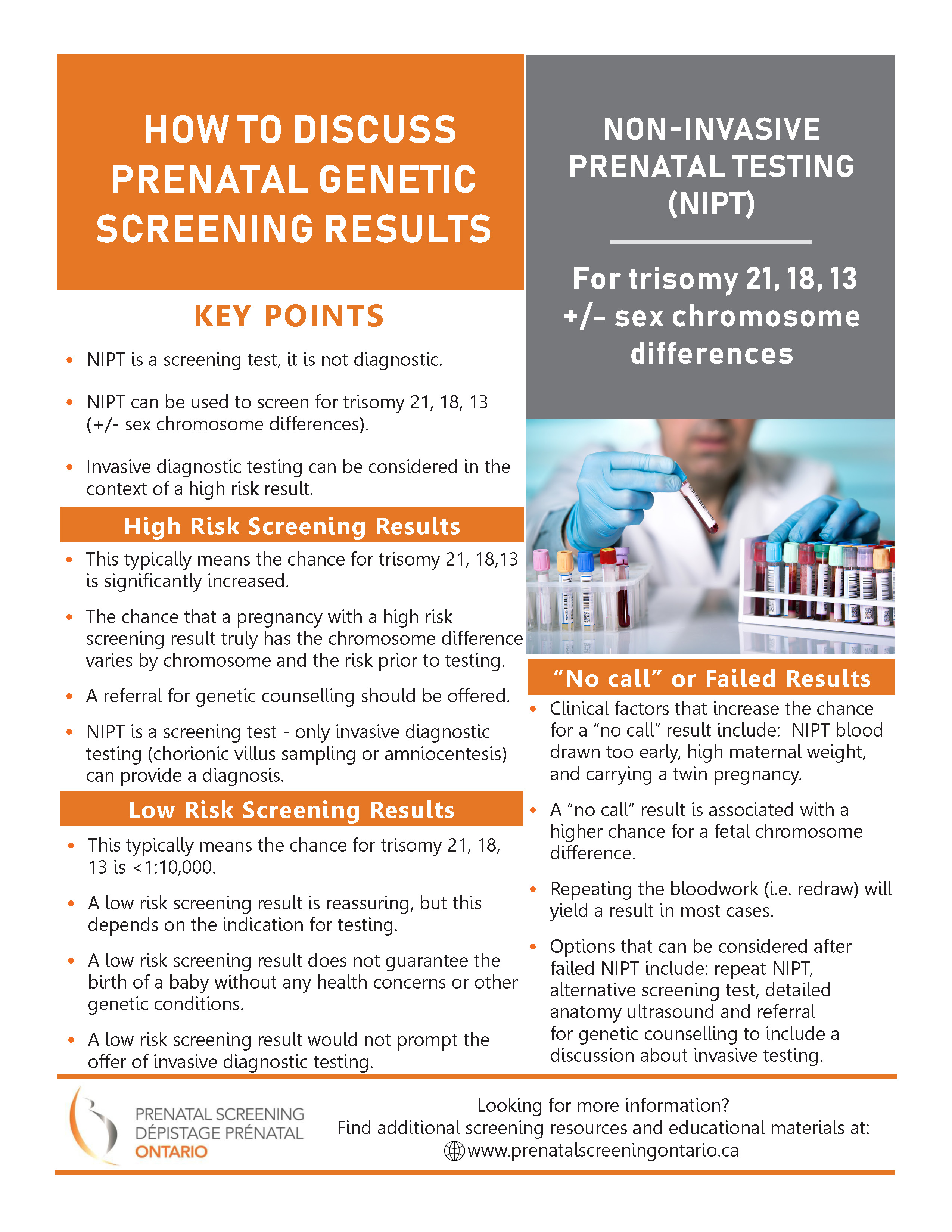Non-Invasive Prenatal Testing (NIPT) Guide
Non-Invasive Prenatal Testing (NIPT) is a prenatal genetic screening test consisting of blood work after 9 or 10 weeks gestation. This test is offered to individuals as either an publicly-funded or private-pay test depending on the situation.
NIPT does not routinely come with an ultrasound. If a pregnant individual decides to have NIPT from the start, they do not need another screening test (such as eFTS). A 11-14 week (nuchal translucency) ultrasound on its own is recommended to get more information about the health of the baby.
Step-by-step instructions are outlined below, to provide guidance to health-care practitioners for how to order this test in Ontario.
Step 1
Determine if Pregnant Individual is Eligible for Publicly-funded NIPT
- NIPT should be offered to all pregnant individuals prior to initiating prenatal genetic screening along with other available options.
- The funding for NIPT varies and will depend on the reason for testing.
- If individuals do not meet any of the criteria for publicly-funded NIPT, they can choose private-pay NIPT.
Step 2
Determine the Appropriate NIPT Lab for Pregnant Individual
Select publicly-funded NIPT or private-pay NIPT to learn about available options.
| Publicly-Funded NIPT | ||||||||||||||||||||||||||||||
1 - Pregnancy may be conceived either naturally or through assisted reproductive technology. 2 - A "vanishing" twin scenario occurs when one of the gestational sacs or fetuses in a set of twins disappears or gets reabsorbed, leading to a singleton pregnancy.
1 - Pregnancy may be conceived either naturally or through assisted reproductive technology. 2 - Twins are not eligible for sex chromosome aneuploidy screening with the HarmonyTM Prenatal Test. 3 - Only monozygotic twins can be screened for sex chromosome aneuploidies with PanoramaTM NIPT. 4 - Chorionicity, rather than zygosity, has an impact on the outcome of twin pregnancies. Zygosity testing can complement, but not replace, ultrasound evaluation of chorionicity in some clinical scenarios. For example, evaluating zygosity through NIPT may impact pregnancy surveillance when chronicity assignment is uncertain, and can help interpret “high risk” aneuploidy results. |
||||||||||||||||||||||||||||||
| Private-Pay NIPT | ||||||||||||||||||||||||||||||
| Private-pay NIPT is available through the Ontario-based laboratories (LifeLabs or Dynacare), as well as through other laboratories based outside of Canada. Prenatal Screening Ontario is unable to endorse any specific private-pay test or laboratory. We encourage you to read about what factors you and the pregnant individuals in your care may choose to consider. |
Step 3
Provide the Completed NIPT Requisition to Pregnant Individual
Dynacare | Harmony Prenatal Test
Download Publicly-funded Requisition
LifeLabs | Panorama NIPT
Download Publicly-funded Requisition
Please note that Dynacare and LifeLabs have separate requisitions for private-pay NIPT, and these can be found on their websites.
Step 5
Communicate Results and Next Steps
- Results will be reported to you by the lab generally within 7-10 business days.
- Communicate results back to the pregnant individual once report is received.
- Ensure continuity of care: forward the report to any other practitioners involved in the care of the pregnant individual.



 Subscribe to this page
Subscribe to this page